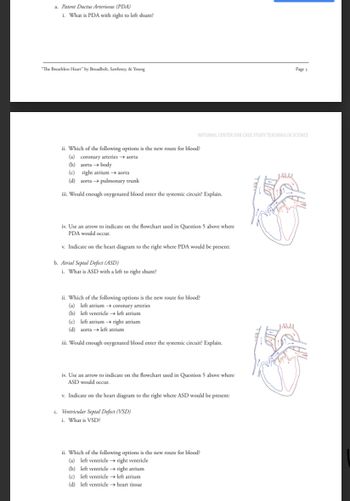Question
Answer all questions besides the one that says i

Transcribed Image Text:a. Patent Ductus Arteriosus (PDA)
i. What is PDA with right to left shunt?
"The Breathless Heart" by Broadbelt, Sawhney, & Young
Page 3
NATIONAL CENTER FOR CASE STUDY TEACHING IN SCIENCE
ii. Which of the following options is the new route for blood?
(a) coronary arteries → aorta
(b) aorta → body
(c) right atrium → aorta
(d) aorta → pulmonary trunk
iii. Would enough oxygenated blood enter the systemic circuit? Explain.
iv. Use an arrow to indicate on the flowchart used in Question 5 above where
PDA would occur.
v. Indicate on the heart diagram to the right where PDA would be present:
b. Atrial Septal Defect (ASD)
i. What is ASD with a left to right shunt?
ii. Which of the following options is the new route for blood?
(a) left atrium → coronary arteries
(b) left ventricle → left atrium
(c) left atrium → right atrium
(d) aorta → left atrium
iii. Would enough oxygenated blood enter the systemic circuit? Explain.
iv. Use an arrow to indicate on the flowchart used in Question 5 above where
ASD would occur.
v. Indicate on the heart diagram to the right where ASD would be present:
c. Ventricular Septal Defect (VSD)
i. What is VSD?
ii. Which of the following options is the new route for blood?
(a) left ventricle → right ventricle
(b) left ventricle → right atrium
(c) left ventricle → left atrium
(d) left ventricle → heart tissue

Transcribed Image Text:Superior and
Inferior venae
cavae
REST OF
THE BODY
Right
Atrium
Tricuspid
valve
Coronary veins
L
Right ventricle
and sinus
HEART
L
Coronary
arteries
Aorta
Aortic
semilunar
valves
Left ventricle
Pulmonary
semilunar
valve
Pulmonary
trunk
Bicuspid
valve
Left atrium
Pulmonary
arteries
LUNG
Pulmonary
veins
Expert Solution
This question has been solved!
Explore an expertly crafted, step-by-step solution for a thorough understanding of key concepts.
This is a popular solution
Trending nowThis is a popular solution!
Step by stepSolved in 3 steps

Knowledge Booster
Similar questions
- why does UTI symptoms occur? (simple and easy)arrow_forward(need help with this question and can you please write in in a paragraph so that i can understand) Zoran Solano, a 20-year-old man was brought into the Emergency Department (ED) after an accident whilst riding on an electric scooter. He was stabilised and transferred to the Orthopaedic Ward for surgery in the morning. BACKGROUND Zoran Solano was out partying with his friends, celebrating a birthday in the Valley. According to his cousin, Eyad, Zoran started drinking at 5pm that day and by the time they left the club around 2am, Zoran was very intoxicated. As they were walking out of the club, Zoran decided to jump on an electric scooter that was parked outside the club. Eyad started running after Zoran, and he saw Zoran weaving in and out of cars on the road at a high speed. Eyad saw Zoran barely manage to avoid fully hitting the concrete column of a building but he jumped off the electric scooter and landed in an awkward position. ASSESSMENT GCS: 15/15, both pupils: 3 equal and…arrow_forward
arrow_back_ios
arrow_forward_ios